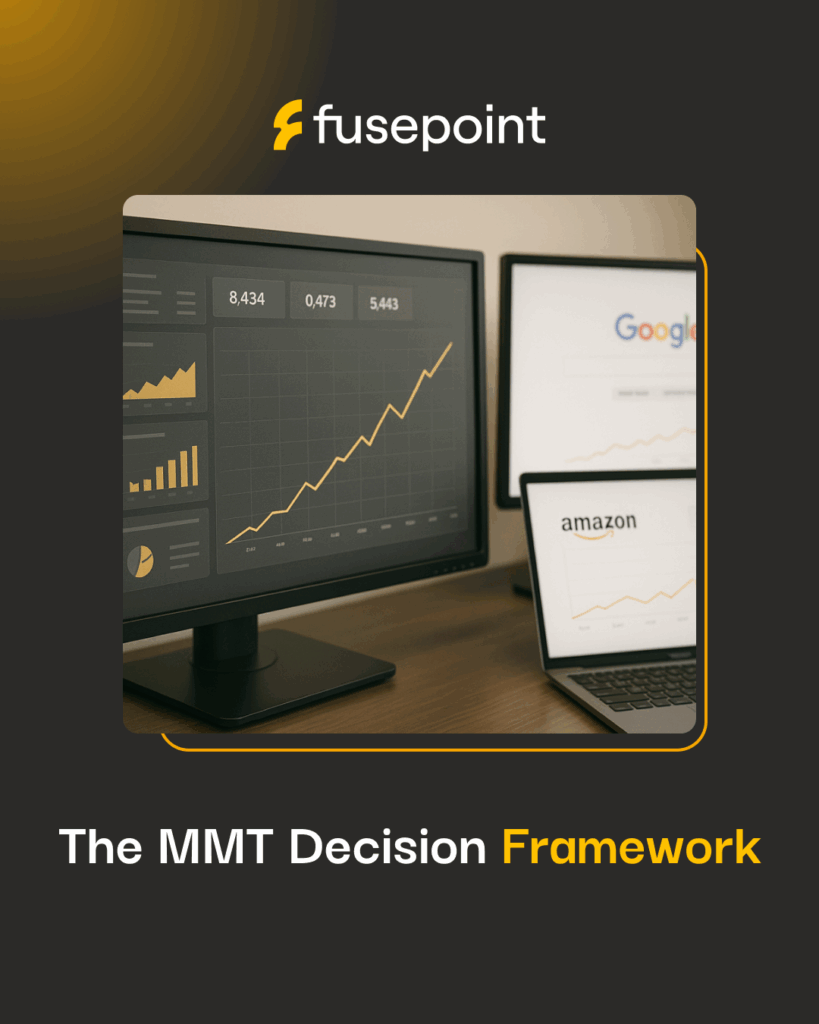Marketing Due Diligence Checklist for PE Firms, Investors, and Corporate Buyers

- 1. What is marketing due diligence?
- 2. Marketing due diligence checklist
- 3. 6 Common red flags identified during diligence
- 4. Case study callout: How fusepoint unearthed $400K in latent profit
- 5. How to apply this checklist in PE and M&A transactions
- 6. Deliver investor confidence with fusepoint’s diagnostic approach to marketing due diligence
The cost is high for private equity firms, investors, and corporate buyers who undervalue marketing in diligence. Deal teams are known to put financials and operations under a microscope, but when it comes to marketing—a crucial arm of commercial due diligence—too many settle for surface-level decks and metrics.
Overlooking digital marketing due diligence can lead to inflated projections, underperforming portfolios, and missed opportunities to tap into hidden growth. It’s not just about reviewing ad spend—marketing diligence involves a nuanced understanding of whether a company’s acquisition engine is durable and scalable. When it’s not, the risks compound, degrading EBITDA and future growth opportunities.
But without a structured framework for evaluating marketing performance in M&A, marketing strategies rarely tie back into ROI or enterprise value. fusepoint’s diagnostic approach addresses key variables like CAC, LTV, channel efficiency, and brand equity with financial discipline equal to that of investors.
What is marketing due diligence?
Financial diligence validates numbers and projects. Operational diligence interrogates processes, supply chain, and management. Marketing diligence assesses the efficiency, durability, and scalability of a company’s systems for inspiring consumer demand.
Key levers like customer acquisition costs, retention, brand strategy, and a host of other marketing variables determine whether a company can sustain growth and whether additional investment will translate into profit2. Yet, many diligence processes overlook the rigor required to adequately interrogate and refine these levers.
Rigorous diligence processes help surface these pitfalls and motivate the clarification of systems and processes. Doing so helps ground marketing projections in traceable, testable evidence—which, for investors, is critical. Without a disciplined viewpoint into marketing efficiency, brands can appear healthier than they really are, inflating valuation and reducing returns post-acquisition.
Marketing due diligence checklist
A rigorous diligence process should examine marketing across at least six key dimensions. Each one reveals not only how a company operates today, but also how sustainable and scalable its performance could be down the line.
#1 Audience & segmentation validation
Many sellers present overly broad TAM figures without showing whether they’ve already made contact with profitable segments. Audience and segmentation diligence should assess:
-
Whether target segments are profitable, not just within reach
-
Whether segmentation has been broken down to demographics alone, or if it integrates other descriptive features like behavior, psychographics vs demographics, and LTV
-
Whether marketing messaging and brand messaging resonate with high-value cohorts, as opposed to one-and-done buyers
With detailed, thorough profiles of core audience segments, valuations tend to be more accurate. And importantly, enduring growth can only occur when a company deeply understands who they’re selling to.
#2 Channel & spend efficiency analysis
A company’s media mix illustrates to investors where growth is coming from and how fragile that expansion might be. Many brands lean heavily on one or two platforms, which can compromise the total health and balance of their media portfolio. A diligence process should:
-
Itemize each channel’s contribution to revenue: paid search, paid social, affiliate, organic, offline, and so on
-
Evaluate each channel’s efficiency, comparing CAC by channel vs. combined CAC
-
Identify any over-dependence on platform algorithms or third-party data, which can shift or erode over time, or be proven fraudulent3
Balanced media planning keeps spending efficient, diversified, and scalable. When overconcentrated, underdeveloped, or otherwise imbalanced, it’s likely propped up by arbitrage—which, in the long run, is unsustainable.
Learn how fusepoint’s media planning services help PE firms, investors, and corporate buyers build strategic, data-driven plans that maximize marketing impact across digital, social, and traditional channels.
#3 CAC, LTV, and ROI diagnostics
Customer acquisition costs and lifetime metrics are instrumental in marketing due diligence. Without them, ad spend efficiency and total enterprise value can’t be easily reconciled. A diligence process should:
-
Calculate CAC comprehensively, crunching all the numbers for media, creative, as well as personnel costs
-
Break down LTV into segments to test whether new customers mirror those who’ve been historically profitable
-
Measure how long it takes to see ROI gains (i.e., how long does it take for your marketing spend to flow back in the form of profit?)
For instance, if numbers show that CAC has been accelerating while LTV stays static, it signals that a deal may be resting on unrealistic or deceptive scaling assumptions.
While CAC measures what it takes to win a customer today, understanding how to calculate CLV will reveal what the customer is worth tomorrow.
#4 Incrementality and measurement rigor
One of the most overlooked diligence questions is, “Do reported results reflect real, measurable incremental growth?”
Companies often report ROAS or attribution metrics that exaggerate marketing’s impact. Without incrementality testing and media mix modeling, it’s impossible to know whether growth is the result of marketing efforts or if it’s incidental (and would have happened in the absence of marketing spend).
A diligence process should:
-
Assess whether effective matched market testing has been conducted, and what methods were used.
-
Inspect the attribution models used (MMM vs MTA vs MMT), weighing last-click against multi-touch, to assess whether budget is being deployed effectively.
-
Evaluate data governance—whether performance is being tracked regularly, transparently, and traceably, so your personnel always have the ability to check their work.
Understanding the difference between attribution vs contribution of marketing efforts is key to measuring true incrementality and avoiding inflated performance metrics.
#5 Brand equity & retention risk factors
-
Measure retention curves and risk of customer churn
-
Assess whether brand equity has been accurately measured in benchmarks like:
- Customer loyalty and satisfaction (NPS)
- Consumer perception and brand lift
- Share of voice and market position
-
Identify whether growth is dependent on offering discounts, which typically demonstrates fragile customer loyalty
Brand equity distinguishes those companies with inflated top-line revenue from those with a healthy core and scalable, repeatable infrastructure that can endure and grow over time.
#6 Tech stack & data infrastructure audit
Without the modern data infrastructure, even the sharpest marketing strategies won’t scale well. Many companies still depend on outdated tools, manual reporting practices, or atomized systems to keep their business running. A diligence process should:
-
Audit any existing marketing automation, CRM, and data analytics stacks
-
Screen for plausible integration initiatives across platforms that could streamline sales, marketing, and finance
-
Identify any reliance on third-party or external agencies currently providing murky reporting
Weak infrastructure consistently packs hidden costs to investors post-close. Conversely, strong infrastructure enables clearer measurements, faster optimizations, and overall risk reduction in future executions.
Through our data infrastructure consulting services, fusepoint partners with organizations to simplify complexity, integrate siloed systems, and build data foundations that support smarter strategies and measurable growth.
6 Common red flags identified during diligence
Inevitably, investors will encounter patterns during marketing due diligence that signal potential weak or blind spots in a company’s marketing engines.
The following red flags can be subtle, but interrogating them is crucial for unmasking investment risks and inflated valuations:
#1 Burying financial outcomes under vanity metrics
Companies frequently report impressions, clicks, or social engagement as proof of performance, but those aren’t strong guiders. Overemphasizing these metrics can create an incomplete picture, often failing to correlate with revenue, profitability, or sustainable long-term growth. CAC, ROAS, SOV, and other numbers tie more directly into ROI, showing a more detailed profile of how marketing plays are really faring.
#2 Channel concentration
Some marketers believe it’s best to focus efforts on a single channel, but overdependence leaves countless businesses vulnerable to the fluctuations intrinsic to marketing:
-
Platform changes
-
Ad cost fluctuations
-
Algorithmic changes
Diversifying the media mix, using a hybrid approach (programmatic, direct, and offline methods) in media buying, and identifying which channels work well at different stages of the funnel are all helpful strategies to mitigate risk.
#3 Fragmented measurement and attribution
Data silos across CRM, ad platforms, and analytics systems make it difficult to accurately track CAC, LTV, or ROI. This form of isolation can critically impact decision-making, leading to misallocated budgets and a murky picture of performance.
One correction is to integrate reporting systems and seek out a comprehensive picture of attribution across the customer journey. Regular audits can also help review data pipelines to correct faulty reporting.
#4 Lack of incrementality testing
Brands often assume that every dollar spent drives new revenue. But unless they identify the causal effect of campaigns, ROI estimates can easily inflate. Controlled incrementality experiments that examine one variable at a time can clarify which channels are consistently drawing activity and incremental revenue (beyond what would have occurred organically).
#5 Underdeveloped creative or messaging strategies
Inconsistent, uninspired branding can suppress engagement and reduce the effectiveness of media spend—even on historically high-performing channels.
But creative also benefits from auditing, whether by testing formats, employing iterative optimization initiatives, or rethinking how it aligns with the real-world customer journey. As such, one intervention is to connect media planning and creative teams, ensuring the content meets the customer where they are (in the environment, context, and funnel stage).
#6 Inadequate tech stack or reporting infrastructure
Disconnected reporting systems, or the use of outdated (or obsolete) tools, can prevent teams from responding to performance trends with agility. If tech stacks haven’t been audited or integrated yet, doing so can significantly clarify ROI projections.
At times, this requires retraining so that teams build internal expertise in marketing, finance, and analytics. Working with a digital marketing agency can also facilitate the efficient interpretation of data and apply it fruitfully to future efforts.
Case study callout: How fusepoint unearthed $400K in latent profit
A top voluntary insurance company faced a mounting challenge: Margins were shrinking, and the ratio of LTV to CAC was approaching critically unsustainable levels. Despite significant investments made in demand capture, the company was struggling to translate spend into profitable growth they could rely on.
Traditional attribution models focused largely on clicks and last-touch metrics, obscuring the true drivers of revenue and kicking underperforming strategies. Fusepoint’s Strategy Consultants intervened with insurance marketing strategies, employing a structured, test-and-learn approach that combined data intelligence solutions with strategic marketing consulting to uncover hidden value and correct and optimize spend allocation.
Key interventions included:
-
Multi-layered incrementality testing – We started by isolating the actual contribution of each channel to incremental revenue, challenging assumptions embedded in click-based attribution models.
-
High-impact channel realignment – Next, we identified channels the company had previously passed over, which were delivering superior efficiency and profitability. Then, we redistributed media spend accordingly.
-
Creative and messaging evaluation – We ensured that campaigns were optimized across formats and aligned with target audience behaviors, maximizing conversion potential.
-
Advanced analytics integration – We centralized disparate data sources into a unified framework, furnishing the leadership team with actionable, real-time insights into campaign performance and ROI.
The results were staggering: The company achieved a 167% lift in incremental revenue, a 33% increase in average order value, and nearly $400K gains in incremental profit—without adding an extra dime to overall spend.
Beyond the immediate financial impact, fusepoint’s approach established a durable, data-steered marketing engine that enabled scalable growth, reliable ROI, and greater clarity for leadership and investors.
How to apply this checklist in PE and M&A transactions
It behooves investors to approach diligence as a step-by-step diagnostic process: The goal isn’t merely to collect data, but to understand how marketing decision-makers can use it to spur tangible financial outcomes.
Here’s how to start:
-
Evaluate audience segmentation, channel mix, and spend efficiency – This allows you to test that CAC, LTV, and ROI metrics are both tenacious and traceable from the start.
-
Assess incrementality and measurement rigor – Controlled testing channels, campaigns, or media buys provide insights into which activities truly drive incremental revenue, versus those that merely correlate with it.
-
Evaluate creative alignment, brand equity, and retention risks – These are crucial factors determining whether a company’s marketing foundations support long-term growth.
-
Audit tech stacks and reporting infrastructure – Centralizing and streamlining data dashboards helps ensure current and future data flows are consistent, accurate, and actionable.
With a tiered approach, PE teams can include marketing diligence into the greater diligence process. In turn, they can begin to:
-
Identifying over- or under-invested channels
-
Evaluate the economic impact of marketing spend
-
Quantify risks that could affect post-acquisition performance
When it’s foundationally informed by finances and tethered directly to ROI, marketing diligence isn’t an accessory—it’s a transformative exercise with the potential to vastly enhance value, both directly and as a strategic tool.
Deliver investor confidence with fusepoint’s diagnostic approach to marketing due diligence
Far from a perfunctory exercise, marketing diligence has real, material impacts on deal outcomes—but not every framework works toward this goal. fusepoint’s diagnostic approach connects marketing performance directly to financial metrics, revealing hidden inefficiencies, validating ad spend, and quantifying incremental revenue that can be built upon.
For PE firms, corporate buyers, and marketing teams alike, diligence reduces risk and unlocks new, unforeseen opportunities. To discover what they are, reach out to a measurement expert today.
fusepoint’s due diligence consulting services specialize in marketing-focused assessments for private equity funds, corporate buyers, and investors engaged in M&A transactions. We help our clients understand the true performance of a target company’s marketing activities, uncover hidden risks, and identify future growth opportunities.
Sources:
Investopedia. Due Diligence: Types and How to Perform. https://www.investopedia.com/terms/d/duediligence.asp
Forbes. Moving Beyond Vanity Metrics: Marketing KPIs That Matter To The C-Suite.
https://www.forbes.com/councils/forbesbusinesscouncil/2025/06/06/moving-beyond-vanity-metrics-marketing-kpis-that-matter-to-the-c-suite/
Forbes. Navigating The Risks Of Third-Party Data In Ad Tech. https://www.forbes.com/councils/forbestechcouncil/2024/10/21/navigating-the-risks-of-third-party-data-in-ad-tech/
Forbes. Arbitrage Is Profiteering From Information Asymmetry—Are You Being Arb’ed?
https://www.forbes.com/sites/augustinefou/2020/12/14/oh-what-fun-it-is-to-arb/
Forbes. Moving Beyond Vanity Metrics: Marketing KPIs That Matter To The C-Suite.
https://www.forbes.com/councils/forbesbusinesscouncil/2025/06/06/moving-beyond-vanity-metrics-marketing-kpis-that-matter-to-the-c-suite/
Growth Method. The Art of Marketing Channel Strategy: Maximising Impact and ROI.
https://growthmethod.com/marketing-channel-strategy/
Analytix Labs. Cross-Channel Marketing Attribution: Understanding the Customer Journey. https://medium.com/@byanalytixlabs/cross-channel-marketing-attribution-understanding-the-customer-journey-7306fa7c2a29
Funnel Blog. What is incrementality testing? https://funnel.io/blog/incrementality-testing
Our Editorial Standards
Reviewed for Accuracy
Every piece is fact-checked for precision.
Up-to-Date Research
We reflect the latest trends and insights.
Credible References
Backed by trusted industry sources.
Actionable & Insight-Driven
Strategic takeaways for real results.








